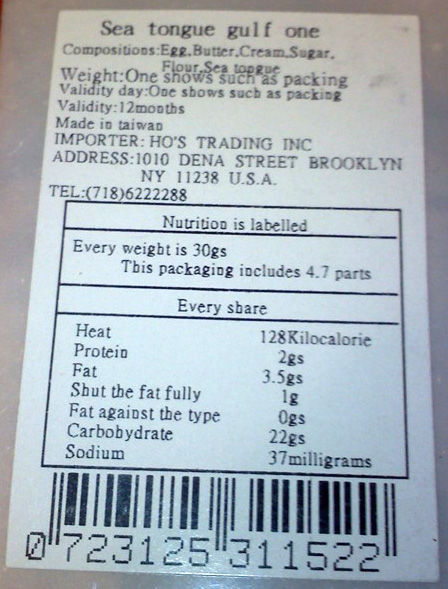Archive for Lost in translation
May 17, 2012 @ 11:06 am· Filed by Ben Zimmer under Language and politics, Lost in translation, Taboo vocabulary, Writing systems
Bloomberg reports (rather delicately) that the name of France's new prime minister, Jean-Marc Ayrault, is causing a bit of problem when it is transliterated into Arabic: "When spoken, his family name is colloquial Arabic in many countries for the third-person singular possessive form of the male sex organ." France's foreign ministry has nipped this problem in the bud, however, by issuing a statement with a recommended transliteration that will prevent people from reading Ayrault's name in Arabic as "(his) dick."
Read the rest of this entry »
Permalink
May 2, 2012 @ 6:12 am· Filed by Victor Mair under Language and culture, Lost in translation
Years ago Bob Ramsey was highly amused by a tee shirt (of course!) in Korea with the slogan "SKY HIGH HORSE FAT". Some time later he learned that that enigmatic slogan was nothing more than a direct translation of the much-loved (and to Koreans romantic) idiom referring to the bountiful harvest season, tiān gāo mǎ féi 天高馬肥. Google Translate lamely renders that as "The days of horse manure", Baidu Fanyi gives the more terse "The horse manure", and Babel Fish hopelessly offers "Day Gao Mafei". But what does tiān gāo mǎ féi 天高馬肥 (literally, "sky high horse fat") really mean?
Read the rest of this entry »
Permalink
April 19, 2012 @ 2:45 am· Filed by Victor Mair under Lost in translation
Murray Clayton, a statistician from the University of Wisconsin, sent in this photograph of a sign on the Tamsui Fisherman's Wharf in Taiwan:

(Click to embiggen.)
Read the rest of this entry »
Permalink
April 15, 2012 @ 12:48 pm· Filed by Victor Mair under Errors, Lost in translation
Steve Kass found this curious expression in the nutrition facts (where "Saturated Fat" usually is) on a package of imported-from-Taiwan crackers at his local Chinese grocery, Jīnmén 金门 ("Golden Gate"; Quemoy [Hokkien Kim-mûi]) in East Hanover, New Jersey. Here is a picture of the label:

Scans of the front and back of the package are shown below.
Read the rest of this entry »
Permalink
March 10, 2012 @ 12:28 pm· Filed by Victor Mair under Lost in translation, Writing
Cindy, who works in my favorite barber shop next to the Penn campus, has the following symbols tattooed on her back:

I instantly recognized the first and last as two quite well-formed Chinese characters. After two or three seconds of puzzling, I realized that the third symbol is another Chinese character written upside down and backwards (how the tattoo artist achieved that is a bit of a mystery, especially since he / she got the first and fourth one in their correct orientation). The second character was more refractory.
Read the rest of this entry »
Permalink
February 18, 2012 @ 12:16 pm· Filed by Victor Mair under Lost in translation
The following sign appears on a vending machine that provides free condoms at a maternity hospital in Beijing:

Read the rest of this entry »
Permalink
February 1, 2012 @ 11:21 pm· Filed by Victor Mair under Lost in translation
Kira Simon-Kennedy took this photograph at a 7-Eleven in Beijing:

(Click to embiggen.)
Read the rest of this entry »
Permalink
January 29, 2012 @ 9:49 pm· Filed by Victor Mair under Language and technology, Lost in translation
Carley De Rosa spotted this sign in the Kunming airport on her way to Laos. Dumbfounded by the Chinglish, not least because what it called an "elevator" was actually an "escalator", on her way back from Laos she made sure to get a photograph of the sign and send it to me for analysis:

Read the rest of this entry »
Permalink
January 25, 2012 @ 5:45 pm· Filed by Geoffrey K. Pullum under Lost in translation, Writing systems
Near my hotel on the Plaça Imperial Tarraco in Tarragona, the indicators to tell pedestrians when they can cross the street have a countdown in seconds to the next green: a minute ticks by, the lights go yellow for the vehicular traffic at 6 seconds, then red at 3 seconds, and finally — 3, 2, 1, liftoff — the little green man is displayed and you can walk across. Only in Tarragona the little green man figure does not just pose in a walking sort of shape: he moves. Those little green arms and legs are working away: he seems to be race-walking. And that's not all: when there's only 7 seconds left, he begins to sprint.
Read the rest of this entry »
Permalink
January 25, 2012 @ 4:54 pm· Filed by Geoffrey K. Pullum under Lost in translation
Six of us were dining in Tarragona on Tuesday night, and the topic of bottled water came up. We all agreed, it is a scandal that diesel fuel is being used to move bottled water around the earth's surface when often it has no chemical advantage whatever over tapwater. What an ecological disaster. What a ripoff. We all insisted we wanted tapwater, and our Spanish-speaking Catalunya-resident host clearly understood us. But three bottles of spa water duly arrived.
Read the rest of this entry »
Permalink
January 24, 2012 @ 1:03 pm· Filed by Victor Mair under Language and culture, Lost in translation
Every year around this time, I write about the relevant Chinese zodiacal animal. Here are some recent posts:
2012 is the year of the dragon, which in Modern Standard Mandarin is lóng (simplified 龙 traditional / complicated 龍).
Read the rest of this entry »
Permalink
January 23, 2012 @ 3:36 am· Filed by Geoffrey K. Pullum under Language and technology, Logic, Lost in translation, Nerdview, Semantics
In the Hotel Ciutat de Tarragona, the beautiful modern hotel in Tarragona where I am currently staying, I ate breakfast in the 1st-floor restaurant (Americans: that would be the 2nd floor), and then came out to take the elevator back up to my 5th-floor room (Americans: 6 floors up). But I was baffled: there was no button to call the elevator for upward journeys. There was just a button labeled with the Down-Arrow symbol for calling the elevator to go back down to the lobby on level 0. Some sort of security, I assumed, to ensure that random restaurant patrons don't go up in the elevator to wander up and down the halls looking for unlocked doors or stealable items. But then how was I to get back up to my room? I'm ashamed to report just how long it took me to resolve the conundrum here. Perhaps you would like to solve it for yourself before you read on.
Read the rest of this entry »
Permalink
January 23, 2012 @ 3:26 am· Filed by Geoffrey K. Pullum under Etymology, Lost in translation
At the Barcelona airport, near the parking structure where I was waiting for a Plana bus to Tarragona yesterday (two hours on the flight; two hours waiting for a bus: sigh), is a large and prominent box of what is obviously important equipment of some kind; and it is clearly labeled as being exclusively for the use of bombers.
Read the rest of this entry »
Permalink





